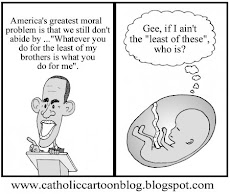Read the rest here. Well, well. Kudos to Newsweek for a balanced story at a time of hysteria. Now can everybody put the pitchforks down and back away real slow?The Catholic sex-abuse stories emerging every day suggest that Catholics have a much bigger problem with child molestation than other denominations and the general population. Many point to peculiarities of the Catholic Church (its celibacy rules for priests, its insular hierarchy, its exclusion of women) to infer that there's something particularly pernicious about Catholic clerics that predisposes them to these horrific acts. It's no wonder that, back in 2002—when the last Catholic sex-abuse scandal was making headlines—a Wall Street Journal-NBC News poll found that 64 percent of those queried thought Catholic priests "frequently'' abused children.
Yet experts say there's simply no data to support the claim at all. No formal comparative study has ever broken down child sexual abuse by denomination, and only the Catholic Church has released detailed data about its own. But based on the surveys and studies conducted by different denominations over the past 30 years, experts who study child abuse say they see little reason to conclude that sexual abuse is mostly a Catholic issue. "We don't see the Catholic Church as a hotbed of this or a place that has a bigger problem than anyone else," said Ernie Allen, president of the National Center for Missing and Exploited Children. "I can tell you without hesitation that we have seen cases in many religious settings, from traveling evangelists to mainstream ministers to rabbis and others."Since the mid-1980s, insurance companies have offered sexual misconduct coverage as a rider on liability insurance, and their own studies indicate that Catholic churches are not higher risk than other congregations. Insurance companies that cover all denominations, such as Guide One Center for Risk Management, which has more than 40,000 church clients, does not charge Catholic churches higher premiums. "We don't see vast difference in the incidence rate between one denomination and another," says Sarah Buckley, assistant vice president of corporate communications. "It's pretty even across the denominations." It's been that way for decades. While the company saw an uptick in these claims by all types of churches around the time of the 2002 U.S. Catholic sex-abuse scandal, Eric Spacick, Guide One's senior church-risk manager, says "it's been pretty steady since." On average, the company says 80 percent of the sexual misconduct claims they get from all denominations involve sexual abuse of children. As a result, the more children's programs a church has, the more expensive its insurance, officials at Guide One said.
The only hard data that has been made public by any denomination comes from John Jay College's study of Catholic priests, which was authorized and is being paid for by the U.S. Conference of Catholic Bishops following the public outcry over the 2002 scandals. Limiting their study to plausible accusations made between 1950 and 1992, John Jay researchers reported that about 4 percent of the 110,000 priests active during those years had been accused of sexual misconduct involving children. Specifically, 4,392 complaints (ranging from "sexual talk" to rape) were made against priests by 10,667 victims. (Reports made after 2002, including those of incidents that occurred years earlier, are released as part of the church's annual audits.)
Experts disagree on the rate of sexual abuse among the general American male population, but Allen says a conservative estimate is one in 10. Margaret Leland Smith, a researcher at the John Jay College of Criminal Justice, says her review of the numbers indicates it's closer to one in 5. But in either case, the rate of abuse by Catholic priests is not higher than these national estimates. The public also doesn't realize how "profoundly prevalent" child sexual abuse is, adds Smith. Even those numbers may be low; research suggests that only a third of abuse cases are ever reported (making it the most underreported crime). "However you slice it, it's a very common experience," Smith says.
- snip -
Allen suggests a final reason we hear so much more about Catholic abuse than transgressions in other religions: its sheer size. It's the second largest single denomination in the world (behind Islam) and the biggest in the United States. (Fifty-one percent of all American adults are Protestant, but they belong to hundreds of different denominations.) "When you consider the per capita data," says Allen, "I don't think they have a larger incidence than other faiths."
Commenting on the Newsweek story, Ross Douthat addresses the tired old "If only they could get married" meme here. He gets it right when he puts it this way:
As I’ve said before, I don’t like it when Catholic leaders fall back on the “child abuse happens everywhere” defense to excuse the church’s egregious failings and cover-ups. I do like it, however, when mainstream media outlets do their job and report that there’s no evidence that the rate of sex abuse is higher among the Catholic clergy than among any other group.It is interesting to note his conclusion that Roman Catholic priests may be abusing children at as low as one fifth the rate that the American population as a whole. You know, the American population as a whole includes journalists. Just saying.





No comments:
Post a Comment